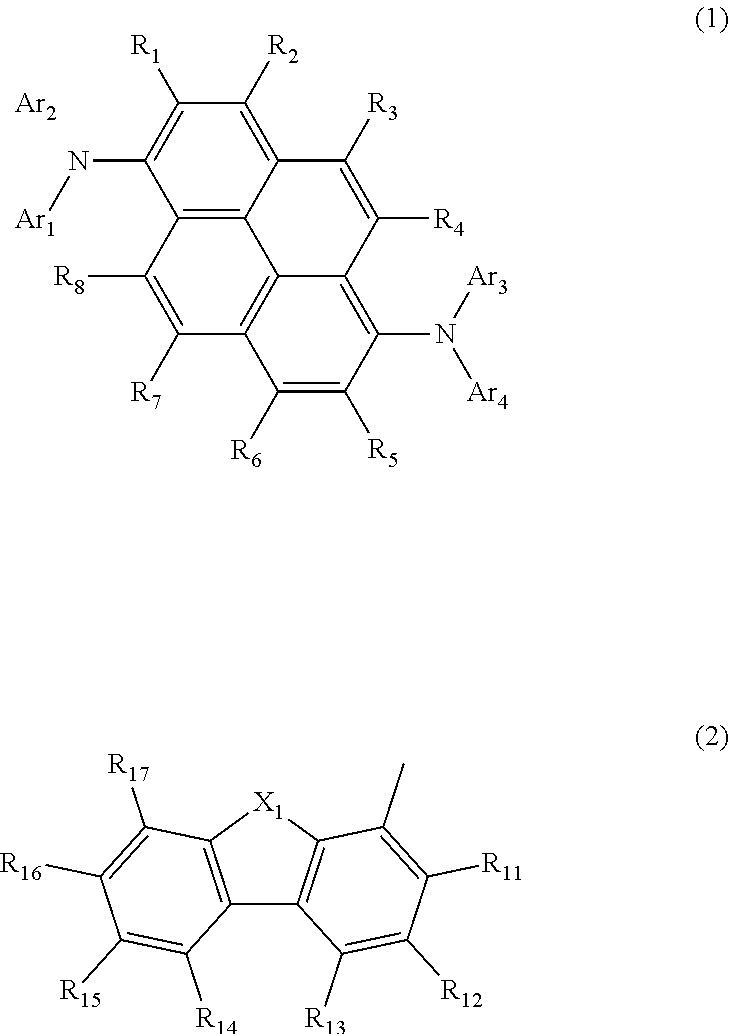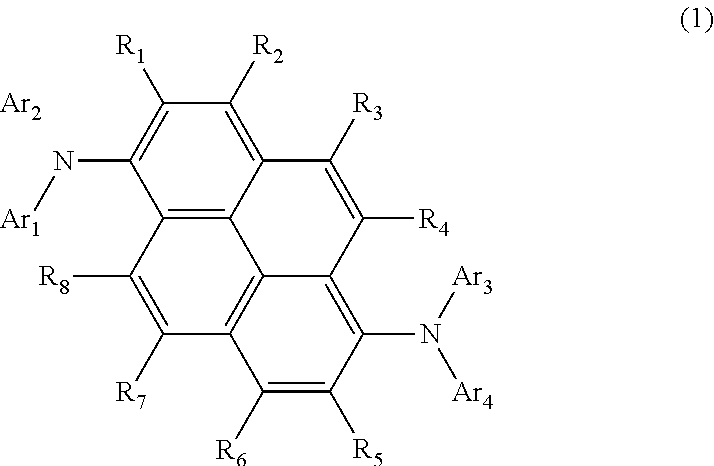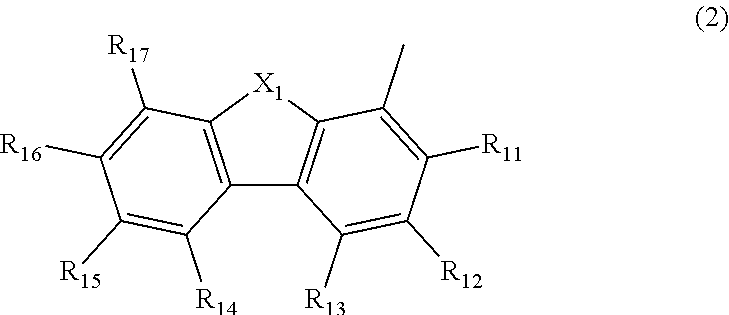Aromatic amine derivative, and organic electroluminescent element comprising same
a technology of organic electroluminescence and amine, which is applied in the direction of luminescent compositions, organic chemistry, chemistry apparatus and processes, etc., can solve the problems of low luminous efficiency, low chromatic purity, and inability to use conventional organic el devices. achieve the effect of high luminous efficiency and high chromatic purity
- Summary
- Abstract
- Description
- Claims
- Application Information
AI Technical Summary
Benefits of technology
Problems solved by technology
Method used
Image
Examples
production example 1
[0132]Aromatic amine derivative D-1 was produced as follows:
(1) Synthesis of Intermediate M1 (Reaction A)
[0133]In a stream of argon, 30.0 g of dibenzofuran and 300 mL of dehydrated tetrahydrofuran (THF) were put in a 1000 mL-recovery flask, and the resulting solution was cooled to −65° C. Then, 120 mL (1.65 M) of a hexane solution of n-butyllithium was added. The resulting mixture was heated gradually, and allowed to react at room temperature for 3 hours. After cooling to −65° C. again, 23.1 mL of 1,2-dibromoethane was added dropwise thereto, and the reaction mixture was heated gradually and a reaction was conducted for 3 hours at room temperature.
[0134]The reaction solution was separated and extracted by adding 2N hydrochloric acid and ethyl acetate, and then the organic phase was washed with clean water and saturated saline and dried with sodium sulfate, and concentrated to obtain a crude product. The crude product was purified with silica gel chromatography (methylene chloride), ...
production example 2
[0141]Aromatic amine derivative D-2 was produced as follows:
(1) Synthesis of Intermediate M3 (Reaction B)
[0142]An intermediate was synthesized in the same manner as in the synthesis of intermediate M2, except that 4-isopropylaniline was used instead of aniline. The intermediate obtained was identified as intermediate M3 by FD-MS (field desorption mass spectrometry) analysis.
(2) Synthesis of Compound D-2 (Reaction C)
[0143]A compound was synthesized in the same manner as in the synthesis of compound D-1, except that intermediate M3 was used instead of intermediate M2. Analysis by FD-MS (field disorption mass spectrometery) was conducted for the compound obtained. The UV absorption maximum wavelength λmax and the flurescence emission maximum wavelength in the toluene solution are given below.
[0144]FDMS, calcd for C64H56N2O2=884. found m / z=884(M+)
[0145]UV(PhMe); λmax=425 nm, FL(PhMe, λex=400 nm); λmax=457 nm
production example 3
[0146]Aromatic amine derivative D-3 was produced as follows:
(1) Synthesis of Intermediate M4 (Reaction D)
[0147]In a stream of argon, 18.7 g of intermediate M1, 3.4 g of acetoamide, 0.81 of copper iodide (I), 15.7 g of potassium carbonate and 90 mL of xylene were put in a 300 mL-recovery flask. After stirring, 0.9 mL of N,N′-dimethylethylenediamine was put, and a reaction was conducted at 170° C. for 18 hours.
[0148]The reaction solution was filtered, and a crude product obtained was washed with toluene, clean water and methanol. Solids obtained were dried under reduced pressure, whereby 8.2 g of solids were obtained. The solids obtained were identified as intermediate M4 by FD-MS (field desorption mass spectrometry) analysis.
(2) Synthesis of Intermediate M5 (Reaction E)
[0149]8.2 g of intermediate M4, 12.2 g of potassium hydroxide, 14 mL of clean water, 37 mL of toluene and 74 mL of ethanol were put in a 300 mL-recovery flask. A reaction was conducted at 110° C. for 8 hours.
[0150]The ...
PUM
| Property | Measurement | Unit |
|---|---|---|
| mass % | aaaaa | aaaaa |
| mass % | aaaaa | aaaaa |
| work function | aaaaa | aaaaa |
Abstract
Description
Claims
Application Information
 Login to View More
Login to View More - R&D
- Intellectual Property
- Life Sciences
- Materials
- Tech Scout
- Unparalleled Data Quality
- Higher Quality Content
- 60% Fewer Hallucinations
Browse by: Latest US Patents, China's latest patents, Technical Efficacy Thesaurus, Application Domain, Technology Topic, Popular Technical Reports.
© 2025 PatSnap. All rights reserved.Legal|Privacy policy|Modern Slavery Act Transparency Statement|Sitemap|About US| Contact US: help@patsnap.com



